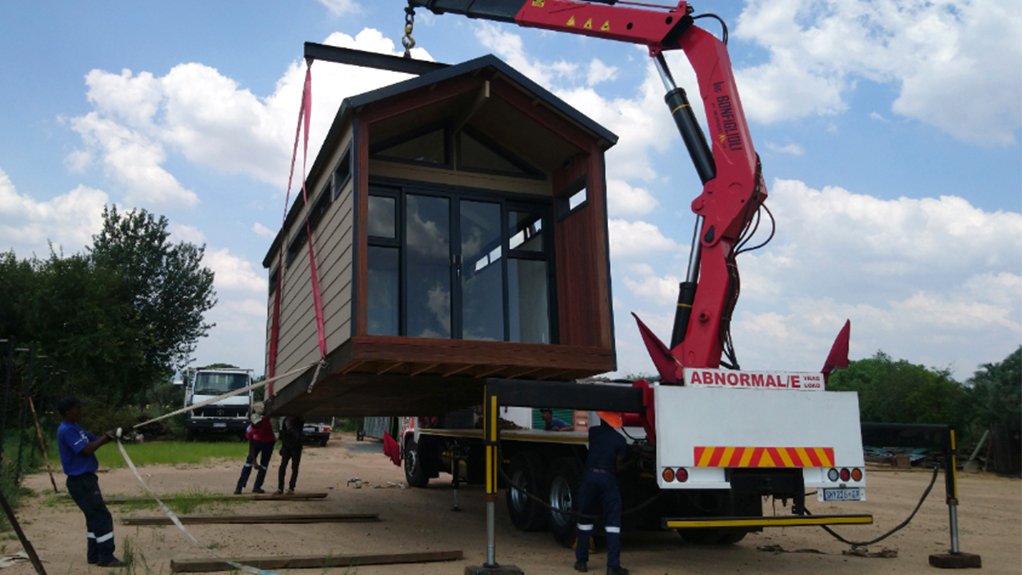Timber-frame construction could help the housing crisis during Covid-19 pandemic




The sawmilling sector makes use of a renewable resource that can be treated to perform better than most construction materials. Credit: Ludwig Sevenster/Forestry Explained
Timber-frame homes and isolation units could be mass produced in panel form and speedily erected by an existing construction workforce. Credit: Eco Log Homes
This article has been supplied as a media statement and is not written by Creamer Media. It may be available only for a limited time on this website.
“We need to abandon the notion that building with wood is reserved for tool sheds or log cabins,” says Roy Southey, executive director of Sawmilling South Africa (SSA), the industry association representing South African sawmillers. SSA, along with the Institute for Timber Construction South Africa (ITC-SA), has offered the South African Government the sector’s combined resources and expertise as part of its response to the Covid-19 pandemic with the provision of timber-frame housing for use as accommodation, clinics, isolation units and much more.
One of the many pressures that the pandemic has placed on South Africa is the need to thin out densely populated informal settlements to slow the spread of the virus. “This will mean providing alternative housing and infrastructure while at the same time addressing the need for decent shelter for people who must remain in isolation or quarantine,” explains Southey.
SSA and the ITC-SA have approached Government with a proposal that timber be regarded as one of the construction materials of choice, and as a longer term solution that will transcend the current crisis and immediate needs.
“Timber as a mainstream construction material is used and favoured globally however perceptions need to be changed in South Africa,” says Southey. Around 70% of people in the developed world live in timber-frame structures, yet South Africans have been conditioned to believe that building with brick and mortar is the only way.
There are a number of compelling reasons in support of timber.
Construction factor
Wood is versatile and lightweight making it ideal for rapid prefabrication of low-income housing as well as larger homes and multi-storey buildings. Correctly treated, wood is in fact highly durable and performs better than many other materials in the event of fire.
Apart from complying with most municipal regulations, timber also offers exceptional thermal insulation and can be extremely cost-effective.
Wood technologies are also harnessing the natural strength of timber and improving it, producing a new range of ‘engineered timber’ that can be used for modern construction, including high-rise buildings.
Cultivation factor
In South Africa, wood for structural timber comes from sustainably grown pine or Eucalyptus trees from responsibly managed commercial timber plantations.
Southey says that it is a myth that timber production causes deforestation. “Deforestation is the removal of trees or clearing of forests for commercial development, firewood or agriculture without replanting.
“Sustainable forestry sees to it that trees are planted, grown and harvested in line with international certification standards and local legislation.”
According to Forestry South Africa, only 6% of the country’s total plantation area – 1.2 million hectares – is harvested annually. Felled trees are replaced in the same year by saplings, often at a ratio of 2:1. This means there is a constant supply of trees for productive purposes for years to come – all of them are sequestering (absorbing and storing) carbon as they grow.
Conservation factor
South Africa is not a tree-rich country like Sweden or Canada. There are only half a million hectares of indigenous forests scattered throughout the country – this is roughly 0.4% of its total land area.
“If it wasn’t for the commercial planting of trees in the early 1900s, the country’s indigenous forests would have been eliminated many years ago for our fuel, furniture and fibre needs.”
South African forestry landscapes are far more complex and diverse than simply rows of planted trees. Only 70% of forestry-owned land is planted to trees with a significant proportion of the unplanted area reserved for biodiversity conservation, natural corridors, grasslands, riverine habitats, indigenous forests and wetlands.
When wood is sourced from a certified plantation, there will also be a chain-of-custody (from the forest to the point-of-sale) which provides assurance that the product is sustainably sourced.
Local factor
The local sawmilling industry alone supports more than 30 000 people, mainly in rural areas while the greater forestry value chain contributes R69 billion to the domestic economy annually. “With the current output of commercially grown pine and eucalyptus sawn timber exceeding 2.1 million cubic metres, wood is an accessible commodity,” notes Southey.
In addition, timber-frame homes can be mass produced in panel form in a factory and speedily erected by an existing construction workforce that can be easily upskilled to assemble pre-manufactured, factory-checked units that not only address the current crisis, but deliver permanent homes.
Carbon factor
Trees are nature’s best carbon captors. South Africa’s plantations remove a significant amount of carbon dioxide from our atmosphere during their rotations of seven to 25 years – and provide oxygen in return.
This carbon remains stored in the wood – whether it’s made into paper, packaging, a roof truss or engineered into cross-laminated timber for high-rise buildings.
Cool factor
With its excellent thermal insulation value, wood can act as a humidity regulator, absorbing moisture in wet conditions and releasing it when the air is dry.
In terms of the psychological hypothesis of ‘biophilia’, wood and natural materials deliver a certain degree of wellbeing, happiness and comfort that other materials can’t match. “Think about how good you feel in a wooded area, green space or a timber building,” Southey says.
All factors considered, wood brings something special but it can have a greater purpose – to ease the housing burden with durable built environments while reducing carbon emissions and supporting local manufacturing.
“Timber is a renewable, valuable and a long-term sustainable source of material ideally suited for use in high volume construction projects,” Southey says. “It’s time we start recognising its potential.”
ABOUT SAWMILLING SOUTH AFRICA
Sawmilling South Africa is an industry association which represents the majority of sawmillers in South Africa.
ABOUT ITC-SA
The Institute for Timber Construction was founded 40 years ago to set and maintain the highest standards in the engineered timber construction industry in South Africa
Queries
Roy Southey | Sawmilling South Africa | 083 679 2457
Comments
Press Office
Announcements
What's On
Subscribe to improve your user experience...
Option 1 (equivalent of R125 a month):
Receive a weekly copy of Creamer Media's Engineering News & Mining Weekly magazine
(print copy for those in South Africa and e-magazine for those outside of South Africa)
Receive daily email newsletters
Access to full search results
Access archive of magazine back copies
Access to Projects in Progress
Access to ONE Research Report of your choice in PDF format
Option 2 (equivalent of R375 a month):
All benefits from Option 1
PLUS
Access to Creamer Media's Research Channel Africa for ALL Research Reports, in PDF format, on various industrial and mining sectors
including Electricity; Water; Energy Transition; Hydrogen; Roads, Rail and Ports; Coal; Gold; Platinum; Battery Metals; etc.
Already a subscriber?
Forgotten your password?
Receive weekly copy of Creamer Media's Engineering News & Mining Weekly magazine (print copy for those in South Africa and e-magazine for those outside of South Africa)
➕
Recieve daily email newsletters
➕
Access to full search results
➕
Access archive of magazine back copies
➕
Access to Projects in Progress
➕
Access to ONE Research Report of your choice in PDF format
RESEARCH CHANNEL AFRICA
R4500 (equivalent of R375 a month)
SUBSCRIBEAll benefits from Option 1
➕
Access to Creamer Media's Research Channel Africa for ALL Research Reports on various industrial and mining sectors, in PDF format, including on:
Electricity
➕
Water
➕
Energy Transition
➕
Hydrogen
➕
Roads, Rail and Ports
➕
Coal
➕
Gold
➕
Platinum
➕
Battery Metals
➕
etc.
Receive all benefits from Option 1 or Option 2 delivered to numerous people at your company
➕
Multiple User names and Passwords for simultaneous log-ins
➕
Intranet integration access to all in your organisation





















